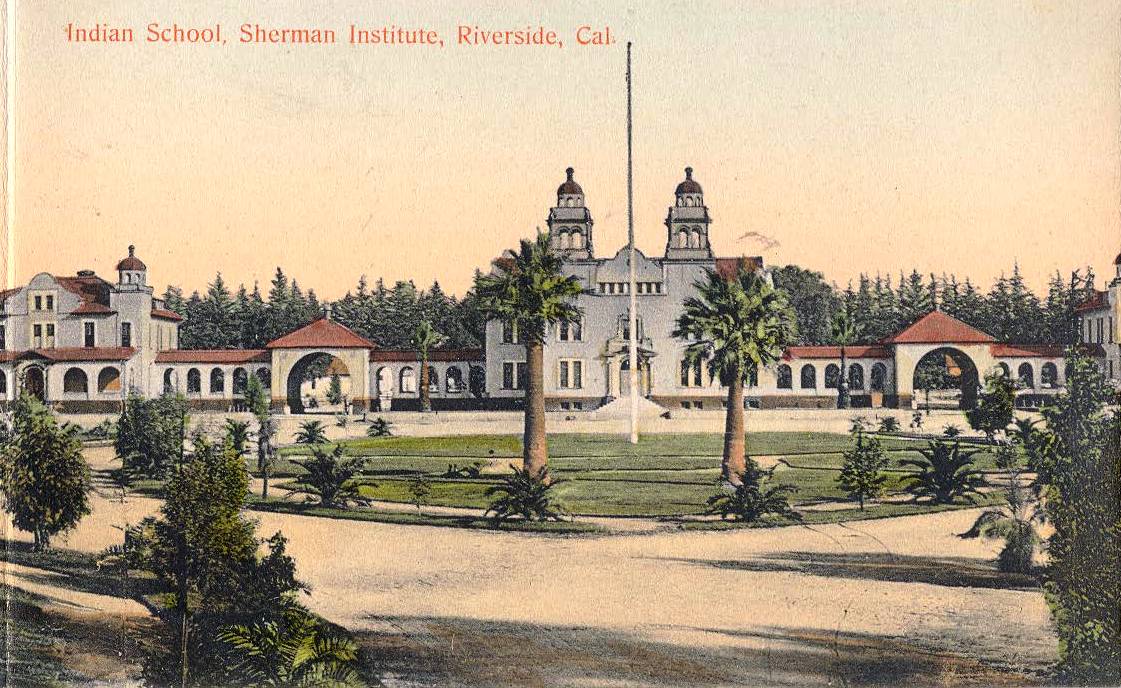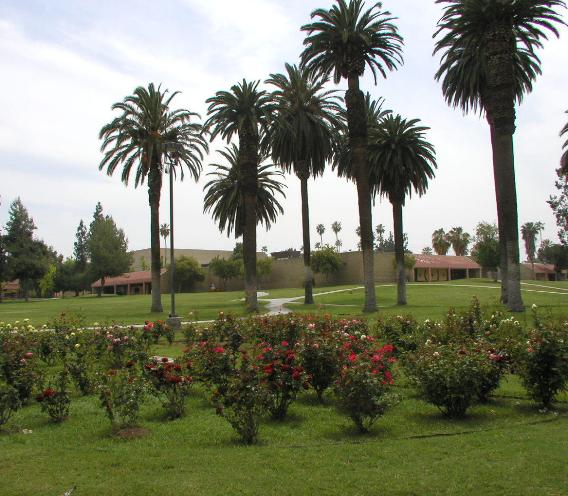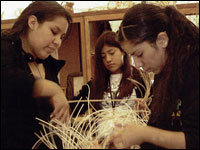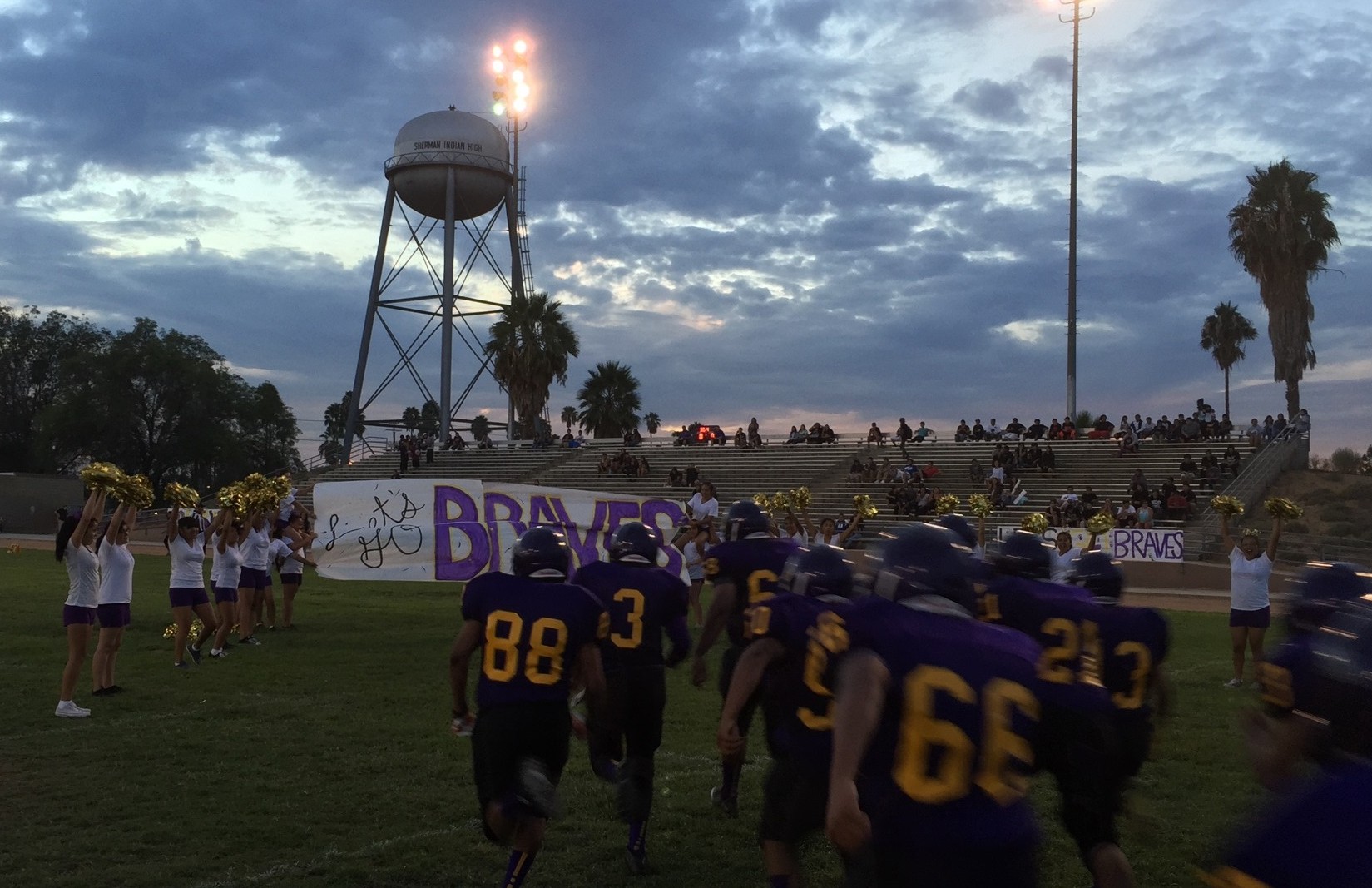Creating a Community Through an Off-Reservation Boarding School
Sherman Indian High School - Riverside, CA
Michaella McBratnie
History

The Perris Indian School opened in 1892 as a day school for Indian students, with an original student body of eight students. By 1902 the school had 350 students and was moved to Riverside, California. This relocation of the school was influenced by Frank Miller, a local entrepreneur, and Superintendent Hall. Miller hoped to use the student population both as a cheap labor force and as a tourist attraction for his Spanish Missionary style inn. Superintendent Hall agreed with Miller's idea believing that vocational education would help with the school’s purpose of civilizing the students. As a result, Hall supported moving the school to the urban location. The government then opened the school as a Federal boarding school renaming it the Sherman Institute. Originally admitting students from local California tribes, the main goal of the Sherman Institute was to assimilate Native Americans into the dominant white culture. (Trafzer, Gilbert and Sisquoc, 21)
By emphasizing their assimilation policy students were stripped of their clothing, had their hair cut against tradition and were not allowed to use their native languages at the school.(Trafzer, Gilbert and Sisquoc, 25). Students were not allowed to return home throughout their stay at Sherman, effectively ripping them from their families and communities. Classes were taught only in english. This, along with limited visits back to their homes promoted the loss of their native language (Bahr, 21).
Since they started off with little funding, the students worked as unpaid labor helping keep the school going. Along with working within the school, the outing system sent students out into the community to work and sometimes live with their employers (Trafzer, Gilbert and Sisquoc, 22). Though this system was created to further their vocational education, frequently it was used as a way of providing the community with cheap labor (Trafzer, Gilbert and Sisquoc, 23).. Students did earn money through their work, but their wages were paid to the school and as a result the school controlled what the students could do with their money (Bahr, 27). Throughout a majority of the school's history, the education provided to its students was focused on low level positions and vocational education rather than preparing the students for white collar jobs or college (Trafzar, Gilbert and Sisquoc, 25).
Although the school was faced with several diseases and epidemics, including Typhoid fever and Tuberculosis, he students at Sherman had better health compared to students at other Indian boarding schools. This was due to the Sherman Ranch supplying the school with fresh food elevating malnutrition (Bahr, 22). Both in attempt to advertise Sherman Institute and encourage students to be healthy, Superintendent Hall promoted students participating in athletics. During the school's first few years, the Football team played against local colleges.
From 1906-1909 Tawaquaptewa , a Hopi leader, and 70 Hopi students attended Sherman Institute as part of a government regulation. Setting an example for his followers, he quickly improved his English and was an example student. While at Sherman the Hopi students participated in a variety of activities, including sports and music. Hopi students also taught other students a traditional game using a spinning top, which was popular with non-Hopi students as well. Though the students were instructed about only European or American music, the Hopi students adapted what they learned and incorporated it into traditional music. Tawaquaptewa and students also performed traditional song and dance at Sherman which further prevented a loss of their culture. While at the Sherman Institute Hopi students both learned about white culture and shared their culture (Gilbert).
In 1934 the Indian Reorganization Act (IRA) replaced the assimilation policy, emphasizing self-determination specifically in education. This new policy changed Native American education attempting to focus on cultural awareness while still allowing students to maintain their native culture (Bahr, 43). The Navajo Special Education Program was a fifteen year program lasting from 1947 to 1962. This was a five year program designed to provide a concentrated study and work education. The focus of the program was on the acquisition of the English language and vocational skills. This program was designed to guarantee Navajo students and other Native American students jobs off reservations (Bahr, 49) . Although this program followed the previous curriculum, it focused on the use of interpreters to improve the language learning process and focused on not demeaning the native student’s culture(Bahr, 51).
Modern Day
(2001-2016)

In 1971, the school became high school accredited and was renamed Sherman Indian High School (Sherman Indian High School). Offering grade 9 to 12, today a majority of teachers and staff at Sherman Indian High school are Native American. The school has expanded it previously vocational focused curriculum to now include college preparatory courses and Native culture classes (Bahr, 131). Currently the student body is made up of 76 tribes creating a diverse cultural background (Sherman Indian High School).
Education Opportunities
Along with the typical high school curriculum, Sherman has been able to create a vocational education program as a result of donations from the San Manuel Band of Serrano Mission Indians totaling $2.5 million. This money was allocated for the development of a career technical education program. This program includes 5 career pathways: health sciences, public services, hospitality in tourism and recreation, agricultural and natural resources and energy and utilities (Bahr, 129).

The school promotes learning about native cultures, providing several classes for students about culture and language. Teachers Lorene Sisquoc and Tara Charley-Baugus have both worked to create courses that promote culture revitalization. The teachers have created a traditional basket weaving class and a Native American Literature course (Bahr, 131). Teacher Charley-Baugus teaches students the Navajo language through the repetition of vocabulary and exams but also through songs (Bear, 2008). A variety of sub institutions have added the the cultural revitalization at Sherman, the Sherman Indian Museum, the Clarke Cultural Center, and Native Traditions Classroom. These organizations on campus provide students with language books, audio recordings to provide resources so students can continue learning about their culture when they are away from their communities (Bahr, 131).
At Risk Students
Indian students are at a greater risk for substance abuse. Sherman Indian School also developed the Choice program, which provides structure and intervention for students who have committed a major violation of school policy. Within this program students must attend class, complete assigned work, spend time in the Quad or the student center ,are prohibited from participating in extracurricular activities, and have their electronics confiscated (Bahr, 122-123).
A zero tolerance behavior policy is in effect forbidding using or possessing alcohol or drugs, participating in gang-related activities, refusing the Choice Program, refusing the substance abuse test and having five or more major violations. This policy was adopted in 2004 however the policy has been adapted to institute interventions for first time violators rather than expulsion from the school. As a result students will participate in Alcoholics Anonymous, Narcotics Anonymous, and/or counseling. If they complete their invention time without further violations, they are allowed to continue their education without further restrictions of the intervention. Sherman Indian High school also now admit students with alcohol or drug problems on a probationary basis. After one year of successfully avoiding major violations, those students were then allowed to return the following year without probation (Bahr, 124).

Athletics and Other Activities
Aligned with the school's history, sports have continued to play a major role in student life. During the fall the school has boys and girls cross country, girls volleyball and boys football. In the Winter there are separate boys and girls basketball teams. Lastly during the spring there is boys and girls track and field, girls softball and boys basketball (Sherman Indian High School Sports). Along with these sports the school also maintains the proper recreational areas for each official sport In addition to maintaining several other recreational activities tennis courts, an olympic size indoor swimming pool, pool tables, poker and domino tournaments (Bahr, 125).
Other cultural extracurriculars include a variety of activities that promote self-determination through culturally relevant activities and work to create a healthy social atmosphere for students. A group of students acting as an Inter-Tribal Council plans pep rallies, spirit week, homecoming events, movies, the annual Pow Wow and more. Student Study Team is a program created and run by students, helps provide solutions to students with academic problems. Students Together Against Negative Decision (STAND) is a program designed to discourage substance abuse and unsafe sexual behavior, students trained as counselors work with their peers to promote making healthy decisions (Bahr 126).
Conclusion
Earlier literature focused on the trauma inflicted by boarding schools including the physical harm through corporal punishment and malnutrition, the cultural loss and the oppressing nature of these programs. However today the histories of schools like Sherman have begun to focus on the former students’ positive perspective of their role in attempting and sometimes succeeding in preserving their culture while gaining an education that would benefit them and their communities (Whalen, 128). The Bureau of Indian Education (BIE) reported that Sherman Indian High school a graduation rate of 100% (Bahr, 134). This shows the school's success in connecting education to cultural and promoting self-determination at Sherman.
Resources
Written:
"Sherman Indian High School." Sherman Indian High School. Accessed April 25, 2016. http://www.shermanindian.org/
Bahr, Diana Meyers. The Students of Sherman Indian School: Education and Native Identity Since 1892. Norman: University of Oklahoma Press, 2014.
Bear, Charla. "American Indian School a Far Cry from the Past." NPR. May 13, 2008. Accessed April 25, 2016. http://www.npr.org/templates/story/story.php?storyId=17645287.
Gilbert, Mathew T. Sakiestewa. "'The Hopi Followers': Chief Tawaquaptewa and Hopi Student Advancement of Sherman Institute, 1906-1909." Journal of American Indian Education 44, no. 2 (2005): 1-23. EBSCOhost
Trafzer, Clifford E., Matthew Sakiestewa Gilbert, and Lorene Sisquoc. "The Indian School on Magnolia Avenue: Voices and Images from Sherman Institute." Corvallis: Oregon State University Press, 2012. ProQuest.
Whalen, Kevin. "Finding the Balance: Student Voices and Culture Loss at Sherman Institute." American Behaviorist Scientist 58, no. 1 (2014): 124-44. Accessed April 25, 2016. Doi: 10.1177/0002764213495026
Images:
Image 1: Sherman Institute Post Card. 1911. Sherman Indian Museum, Riverside, California. Retrieved from ucrtoday.ucr.edu.
Image 2: Bureau of Indian Education, Riverside, California. Accessed April 26, 2016. Retrieved from sihs.bie.edu.
Image 3: Basket Weaving Class. May 13, 2008. Sherman Indian High School, Riverside, California. Retrieved from npr.org.
Image 4: Sherman Indian High School Braves Game. Sherman Indian High School, Riverside, California. Retrieved from shermanindian.org.
Further Reading
Bahr, Diana Meyers. The Students of Sherman Indian School: Education and Native Identity Since 1892. Norman: University of Oklahoma Press, 2014.
Gilbert, Mathew T. Sakiestewa. "'The Hopi Followers': Chief Tawaquaptewa and Hopi Student Advancement of Sherman Institute, 1906-1909." Journal of American Indian Education 44, no. 2 (2005): 1-23. EBSCOhost
Trafzer, Clifford E., Matthew Sakiestewa Gilbert, and Lorene Sisquoc. "The Indian School on Magnolia Avenue: Voices and Images from Sherman Institute." Corvallis: Oregon State University Press, 2012. ProQuest.